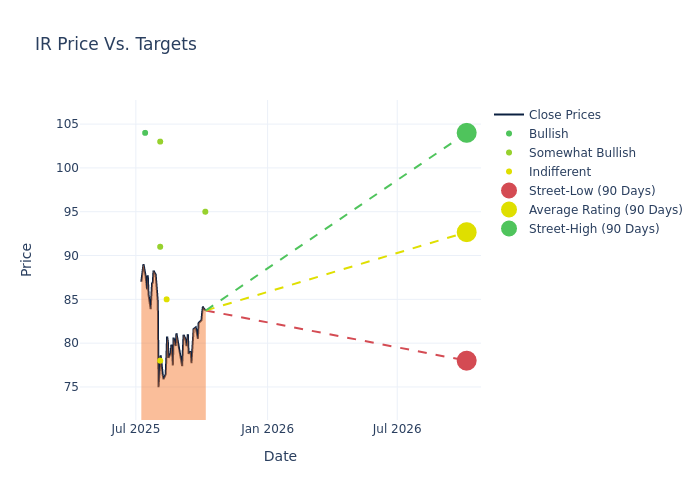A Glimpse Into The Expert Outlook On Ingersoll Rand Through 8 Analysts
Author: Benzinga Insights | October 06, 2025 03:01pm
During the last three months, 8 analysts shared their evaluations of Ingersoll Rand (NYSE:IR), revealing diverse outlooks from bullish to bearish.
The table below provides a snapshot of their recent ratings, showcasing how sentiments have evolved over the past 30 days and comparing them to the preceding months.
|
Bullish |
Somewhat Bullish |
Indifferent |
Somewhat Bearish |
Bearish |
| Total Ratings |
1 |
4 |
3 |
0 |
0 |
| Last 30D |
0 |
1 |
0 |
0 |
0 |
| 1M Ago |
0 |
0 |
0 |
0 |
0 |
| 2M Ago |
0 |
0 |
1 |
0 |
0 |
| 3M Ago |
1 |
3 |
2 |
0 |
0 |
The 12-month price targets assessed by analysts reveal further insights, featuring an average target of $92.88, a high estimate of $104.00, and a low estimate of $78.00. This upward trend is apparent, with the current average reflecting a 4.81% increase from the previous average price target of $88.62.

Breaking Down Analyst Ratings: A Detailed Examination
In examining recent analyst actions, we gain insights into how financial experts perceive Ingersoll Rand. The following summary outlines key analysts, their recent evaluations, and adjustments to ratings and price targets.
| Analyst |
Analyst Firm |
Action Taken |
Rating |
Current Price Target |
Prior Price Target |
| Joseph O'Dea |
Wells Fargo |
Raises |
Overweight |
$95.00 |
$83.00 |
| Chris Snyder |
Morgan Stanley |
Lowers |
Equal-Weight |
$85.00 |
$88.00 |
| Nathan Jones |
Stifel |
Lowers |
Hold |
$78.00 |
$95.00 |
| Julian Mitchell |
Barclays |
Lowers |
Overweight |
$91.00 |
$92.00 |
| Michael Halloran |
Baird |
Raises |
Outperform |
$103.00 |
$97.00 |
| Nathan Jones |
Stifel |
Raises |
Hold |
$95.00 |
$78.00 |
| Andrew Kaplowitz |
Citigroup |
Raises |
Buy |
$104.00 |
$91.00 |
| Julian Mitchell |
Barclays |
Raises |
Overweight |
$92.00 |
$85.00 |
Key Insights:
- Action Taken: Analysts frequently update their recommendations based on evolving market conditions and company performance. Whether they 'Maintain', 'Raise' or 'Lower' their stance, it reflects their reaction to recent developments related to Ingersoll Rand. This information provides a snapshot of how analysts perceive the current state of the company.
- Rating: Unveiling insights, analysts deliver qualitative insights into stock performance, from 'Outperform' to 'Underperform'. These ratings convey expectations for the relative performance of Ingersoll Rand compared to the broader market.
- Price Targets: Analysts set price targets as an estimate of a stock's future value. Comparing the current and prior price targets provides insight into how analysts' expectations have changed over time. This information can be valuable for investors seeking to understand consensus views on the stock's potential future performance.
Navigating through these analyst evaluations alongside other financial indicators can contribute to a holistic understanding of Ingersoll Rand's market standing. Stay informed and make data-driven decisions with our Ratings Table.
Stay up to date on Ingersoll Rand analyst ratings.
Get to Know Ingersoll Rand Better
Ingersoll Rand was formed through the merger of Gardner Denver and Ingersoll Rand's industrial segment. The firm's portfolio consists of two business lines: industrial technologies and services, and precision and science technologies. Ingersoll Rand serves a variety of end markets, including industrial, medical, and energy. Its broad portfolio of products includes compression, blower and vacuum, and fluid management. Ingersoll Rand generated roughly $7.2 billion in revenue in 2024.
A Deep Dive into Ingersoll Rand's Financials
Market Capitalization Analysis: Above industry benchmarks, the company's market capitalization emphasizes a noteworthy size, indicative of a strong market presence.
Revenue Growth: Ingersoll Rand displayed positive results in 3M. As of 30 June, 2025, the company achieved a solid revenue growth rate of approximately 4.58%. This indicates a notable increase in the company's top-line earnings. As compared to competitors, the company encountered difficulties, with a growth rate lower than the average among peers in the Industrials sector.
Net Margin: Ingersoll Rand's net margin is below industry averages, indicating potential challenges in maintaining strong profitability. With a net margin of -6.11%, the company may face hurdles in effective cost management.
Return on Equity (ROE): Ingersoll Rand's ROE is below industry averages, indicating potential challenges in efficiently utilizing equity capital. With an ROE of -1.12%, the company may face hurdles in achieving optimal financial returns.
Return on Assets (ROA): The company's ROA is below industry benchmarks, signaling potential difficulties in efficiently utilizing assets. With an ROA of -0.63%, the company may need to address challenges in generating satisfactory returns from its assets.
Debt Management: The company maintains a balanced debt approach with a debt-to-equity ratio below industry norms, standing at 0.48.
Analyst Ratings: Simplified
Analysts are specialists within banking and financial systems that typically report for specific stocks or within defined sectors. These people research company financial statements, sit in conference calls and meetings, and speak with relevant insiders to determine what are known as analyst ratings for stocks. Typically, analysts will rate each stock once a quarter.
Beyond their standard evaluations, some analysts contribute predictions for metrics like growth estimates, earnings, and revenue, furnishing investors with additional guidance. Users of analyst ratings should be mindful that this specialized advice is shaped by human perspectives and may be subject to variability.
Breaking: Wall Street's Next Big Mover
Benzinga's #1 analyst just identified a stock poised for explosive growth. This under-the-radar company could surge 200%+ as major market shifts unfold. Click here for urgent details.
This article was generated by Benzinga's automated content engine and reviewed by an editor.
Posted In: IR





